茶道と聞けば、多くの人が千利休の名を思い浮かべるでしょう。しかし、その千利休を祖としながら、なぜ「表千家」と「裏千家」という二つの大きな流派が存在するのでしょうか。同じ源流を持ちながら、それぞれが育んできた独自の美意識や作法には、知れば知るほど面白い違いが隠されています。
- 三代で分かれた家の歴史: 一つの家が、なぜ表と裏に分かれたのか。その背景には千利休の孫の時代の決断がありました。
- 一服に込められた思想の違い: 表千家が重んじる「簡素の美」と、裏千家が追求する「おもてなしの心」。お茶の点て方一つにも、その思想が色濃く反映されています。
- 道具選びに現れる美意識: 茶筅(ちゃせん)の色から道具の華やかさまで、二つの流派が好む道具には明確なスタイルの違いがあります。
茶道の巨人・千利休から続く道
茶道の世界は、安土桃山時代の茶人・千利休によって大成された「わび茶」の精神を根幹としています。その教えは、時の権力者である豊臣秀吉にも影響を与えるほど、当時の文化の中心にありました。しかし、利休の死後、その血筋と教えは一つの道だけを歩んだわけではありませんでした。
なぜ「表」と「裏」に分かれたのか
千利休の茶道は、孫である三代目・千宗旦(せんのそうたん)に受け継がれました。宗旦には4人の息子がおり、この息子たちの代で千家は三つに分かれることになります。これが現代に続く「三千家(さんせんけ)」の始まりです。
三男の江岑宗左(こうしんそうさ)は、千家の家督を継ぎ、千家の象徴である茶室「不審菴(ふしんあん)」を守りました。この不審菴が表通りに面していたことから「表千家」と呼ばれるようになります。
一方、四男の仙叟宗室(せんそうそうしつ)は、宗旦の隠居に伴い、裏通りに建てられた茶室「今日庵(こんにちあん)」を受け継ぎました。これが「裏千家」の始まりです。ちなみに、次男の宗守は京都の武者小路通りに茶室「官休庵(かんきゅうあん)」を構え、「武者小路千家」を興しました。
このように、家の場所が「表」と「裏」にあったことが、二つの流派の名前の直接的な由来となったのです。
作法と思想、それぞれの個性
分かれた家は、それぞれ独自の道を歩み、作法や思想にも特徴的な違いが生まれていきました。
表千家は、千家の本家として利休以来の伝統を忠実に守ることを重んじ、質実剛健で簡素な美を追求します。作法も古くからの形を大切にし、余計なものをそぎ落とした「ありのまま」の姿を良しとする傾向があります。
対照的に裏千家は、「一客一亭」の精神を大切にし、客をもてなす心を最大限に表現することを追求します。そのため、伝統を尊重しつつも、時代に合わせた新しい点前や道具を積極的に取り入れ、多くの人に茶道の魅力を開かれた形で伝えようとする姿勢が特徴です。その門戸の広さから、現在では最も大きな流派となっています。
二つの流派、今後の展望
表千家と裏千家は、それぞれ異なるアプローチで千利休の精神を現代に伝えています。どちらが優れているということではなく、それぞれに深い哲学と魅力があります。近年では、流派を超えた交流も行われるなど、互いの違いを尊重しながら茶道文化全体の発展に寄与しています。
解説ポイント①:三代で分かれた家の歴史
千利休から三代目・宗旦の時代までは、千家は一つでした。しかし、宗旦が息子たちに家督を譲る際、千家の茶道が永く続いていくために、家を分けるという道を選んだとされています。
- 表千家(三男・宗左): 千家の家督と、利休の象-徴である茶室「不審菴」を継承。本家として、利休の「わび茶」の精神性をストイックに守り伝える役割を担いました。
- 裏千家(四男・宗室): 父・宗旦と共に隠居先の茶室「今日庵」を継承。加賀前田家など大名家に仕えた経験から、より多くの人々をもてなすための華やかさや工夫を取り入れたスタイルを確立しました。
- 武者小路千家(次男・宗守): 高松松平家に仕え、武家社会との関わりの中で独自の茶風を築きました。
このように、息子たちがそれぞれ異なる環境で茶道を発展させたことが、三千家それぞれの個性を形作る大きな要因となったのです。
解説ポイント②:一服に込められた思想の違い
二つの流派の思想の違いは、お茶の点て方に最も象徴的に現れます。
表千家の薄茶
- 泡の立て方: 泡をあまり立てず、点てたお茶の中央に泡が三日月形に集まる「月ノ輪」と呼ばれる状態を目指します。
- 思想: これは、お茶本来の味と香りを直接的に味わうことを重視する表千家の考え方を反映しています。余計な手を加えず、自然な状態を良しとする「わび」の精神がここにあります。
裏千家の薄茶
- 泡の立て方: 茶筅を素早く振り、表面全体がきめ細かくクリーミーな泡で覆われるように点てます。カプチーノのフォームにも例えられます。
- 思想: 豊かな泡は口当たりをまろやかにし、苦みを和らげる効果があります。これは、何よりも客人に美味しくお茶を飲んでもらいたいという「おもてなしの心」を最優先する裏千家の思想の現れです。
同じ薄茶一服でも、表千家は素材そのものの美を、裏千家はもてなしの工夫を重んじるという、美意識の違いが明確に見て取れます。
解説ポイント③:道具選びに現れる美意識
使用する道具、特に茶筅(ちゃせん)にも、それぞれの流派の美意識が反映されています。
- 表千家が好む道具:
- 茶筅: 自然な風合いの白竹に加え、**煤竹(すすだけ)**の茶筅も好んで使われます。煤竹は、古い茅葺屋根の骨組みとして長年燻された竹から作られ、落ち着いた深い色合いが特徴です。
- 全体的な傾向: 道具全般において、華美な装飾を排した、シンプルで簡素なものを好む傾向があります。一つ一つの道具が持つ本来の美しさを静かに味わうことを大切にします。
- 裏千家が好む道具:
- 茶筅: 主に、清々しい印象の**白竹(しらたけ)**の茶筅が用いられます。
- 全体的な傾向: 客人をもてなすため、季節感あふれる華やかな絵柄の茶碗や、独創的で美しいデザインの道具を積極的に取り入れます。道具の取り合わせによって、茶席全体の雰囲気を豊かに演出しようとします。
このように、道具一つをとっても、表千家は「内省的で静的な美」、裏千家は「開放的で動的な美」を志向していることがわかります。
参考文献
- 茶道の流派…表千家・裏千家・武者小路千家の違いとは [茶道] All About
- 【栃木和文化ナビ】茶道の流派~歴史や流派の違いを知ろう!~ – あまのや
- 裏千家と表千家の違い:日本茶道の二大流派を徹底解説 – GreenTeaTokyo
- What are the differences between Ura Senke and Omote Senke Tea Ceremony Schools? – Mai-ko
【English Article】
Omotesenke vs. Urasenke: Key Differences in History, Etiquette, and Philosophy Explained in 5 Minutes
When one thinks of the Japanese tea ceremony, the name Sen no Rikyū often comes to mind. But why are there two major schools, “Omotesenke” and “Urasenke,” both originating from this single master? Despite sharing the same roots, each has cultivated its own unique aesthetics and practices, revealing fascinating differences the more you learn.
- A Family Divided by the Third Generation: Discover the historical decision by Sen no Rikyū’s grandson that led to the branching of one family into “front” and “back” houses.
- Contrasting Philosophies in a Single Bowl: Omotesenke emphasizes the “beauty of simplicity,” while Urasenke pursues the “spirit of hospitality.” These core ideas are vividly reflected in the way they prepare tea.
- Aesthetics Revealed in Utensil Choice: From the color of the tea whisk (chasen) to the ornate nature of the utensils, the two schools have distinct preferences in their equipment.
The Path from the Giant of Tea, Sen no Rikyū
The world of the Japanese tea ceremony is founded on the spirit of “wabi-cha,” perfected by the tea master Sen no Rikyū during the Azuchi-Momoyama period. His teachings were so influential that they shaped the culture of the era, even impacting powerful figures like Toyotomi Hideyoshi. However, after Rikyū’s death, his lineage and teachings did not follow a single path.
Why the Split into “Front” and “Back”?
Sen no Rikyū’s way of tea was passed down to his grandson, the third-generation head, Sen Sōtan. Sōtan had four sons, and it was in their generation that the Sen family split into three. This marked the beginning of the “San-Senke” (the three Sen houses) that continue to this day.
The third son, Kōshin Sōsa, inherited the headship of the family and stewardship of its symbolic tea house, “Fushin-an.” Because this tea house faced the main street (omote-dōri), his school came to be known as Omotesenke (the “front” Sen house).
Meanwhile, the fourth son, Sensō Sōshitsu, inherited the “Konnichi-an” tea house, which was built on the back street (ura-dōri), upon his father Sōtan’s retirement. This became the foundation of Urasenke (the “back” Sen house). Incidentally, the second son, Sōshu, established his tea house, “Kankyū-an,” on Mushanokōji street in Kyoto, founding the Mushanokōjisenke school.
Thus, the physical locations of their respective houses, “front” and “back,” became the direct origins of the names of these two major schools.
Distinct Personalities in Practice and Philosophy
As the families diverged, they each developed their own unique characteristics in etiquette and philosophy.
Omotesenke, as the main lineage, places great importance on faithfully preserving the traditions established by Rikyū. It pursues a simple, unadorned beauty and tends to favor “as-is” naturalness, stripping away anything superfluous.
In contrast, Urasenke cherishes the spirit of “ichigo ichie” (a once-in-a-lifetime encounter) and seeks to express the heart of hospitality for the guest to the fullest. While respecting tradition, it actively incorporates new styles and utensils that suit the times, striving to convey the appeal of the tea ceremony in an open and accessible manner. This inclusiveness has made it the largest school today.
The Future of the Two Schools
Omotesenke and Urasenke each transmit the spirit of Sen no Rikyū to the modern era through different approaches. Neither is superior; both possess profound philosophies and charm. In recent years, there has been increasing interaction across school boundaries, contributing to the development of the broader tea culture while respecting their mutual differences.
Analysis Point ①: A Family Divided by the Third Generation
Until the time of the third-generation head, Sōtan, the Sen family was a single entity. However, when Sōtan passed on the headship to his sons, it is believed he chose to divide the house to ensure the long-term continuation of the Sen family’s way of tea.
- Omotesenke (Third Son, Sōsa): Inherited the main family lineage and Rikyū’s symbolic Fushin-an tea house. As the head family, he took on the role of stoically preserving and passing down the spirituality of Rikyū’s “wabi-cha.”
- Urasenke (Fourth Son, Sōshitsu): Inherited the Konnichi-an tea house with his retiring father, Sōtan. Through his experience serving feudal lords like the Maeda clan of Kaga, he established a style that incorporated a sense of splendor and creativity to entertain a wider range of people.
- Mushanokōjisenke (Second Son, Sōshu): Served the Matsudaira clan of Takamatsu and developed a unique style of tea through his connections with samurai society.
The fact that the sons developed their tea practices in different environments was a major factor in shaping the distinct character of each of the three Sen houses.
Analysis Point ②: Contrasting Philosophies in a Single Bowl of Tea
The philosophical differences between the two schools are most symbolically expressed in how they prepare thin tea (usucha).
Omotesenke’s Usucha
- Whisking Style: The tea is not whisked vigorously. The aim is to create a state called “tsuki no wa” (moon ring), where the foam gathers in a crescent shape in the center of the bowl.
- Philosophy: This reflects Omotesenke’s emphasis on directly savoring the original flavor and aroma of the tea itself. It embodies the spirit of “wabi,” which finds value in the natural state, free from excessive manipulation.
Urasenke’s Usucha
- Whisking Style: The whisk is moved rapidly to create a fine, creamy foam that covers the entire surface, often compared to the froth of a cappuccino.
- Philosophy: The rich foam gives the tea a milder mouthfeel and softens its bitterness. This is a manifestation of Urasenke’s core philosophy of prioritizing hospitality, desiring above all for the guest to enjoy a delicious bowl of tea.
Even in a single bowl of thin tea, one can clearly see the difference in aesthetics: Omotesenke values the beauty of the material itself, while Urasenke emphasizes creative hospitality.
Analysis Point ③: Aesthetics Revealed in Utensil Choice
The aesthetic preferences of each school are also reflected in the utensils they use, particularly the tea whisk (chasen).
- Utensils Favored by Omotesenke:
- Chasen (Tea Whisk): In addition to natural white bamboo, they also favor whisks made of susudake (smoked bamboo). Susudake is crafted from bamboo that has been naturally smoked for many years in the rafters of traditional thatched-roof houses, giving it a deep,落ち着いた color.
- Overall Tendency: They generally prefer simple, unadorned utensils that are free of ornate decoration. The focus is on quietly appreciating the inherent beauty of each tool.
- Utensils Favored by Urasenke:
- Chasen (Tea Whisk): They primarily use whisks made of shiratake (white bamboo), which has a fresh, clean appearance.
- Overall Tendency: To entertain guests, they actively incorporate tea bowls with vibrant, seasonal patterns and creatively designed utensils. They seek to enrich the overall atmosphere of the tea gathering through the combination of their chosen tools.
Thus, even in the choice of a single utensil, one can see that Omotesenke trends toward an introspective and static beauty, while Urasenke leans toward an open and dynamic beauty.

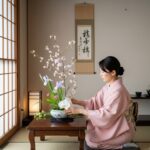
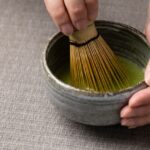
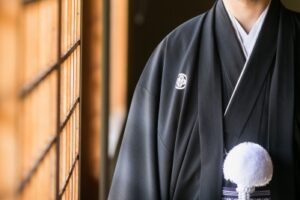
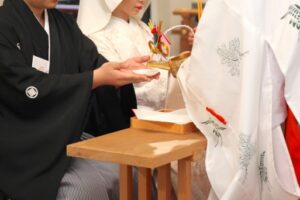
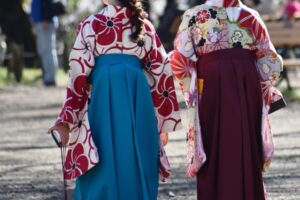

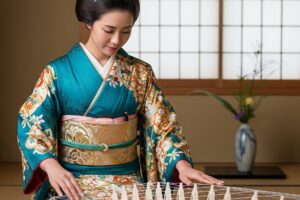

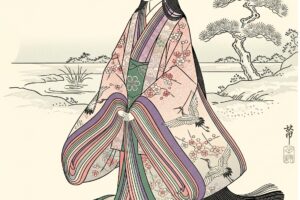
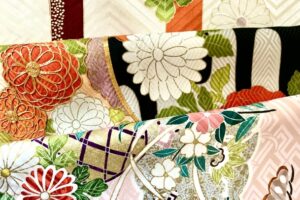
コメントを残す